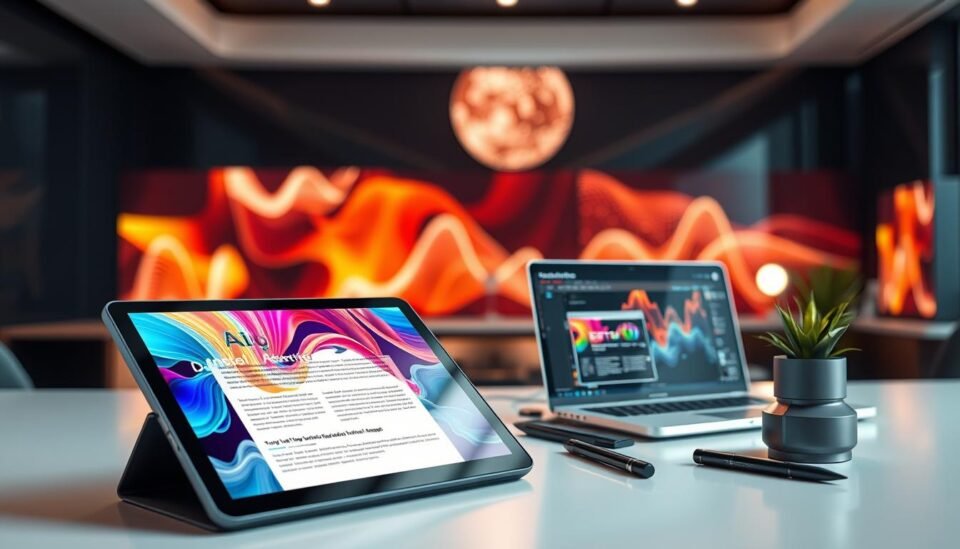Imagine crafting engaging blog posts, social media captions, or video scripts in minutes instead of days. Sounds impossible? Not anymore. Advanced tools are reshaping how we approach storytelling, blending human creativity with machine efficiency to produce results that captivate audiences.
Traditional methods often involve tedious planning and repetitive tasks. Now, platforms like OpenAI’s GPT-4 automate scriptwriting, generate storyboards, and even refine drafts. This shift isn’t about replacing writers—it’s about amplifying their potential. By handling routine work, these systems free creators to focus on strategy and originality.
Businesses see the value too. Faster turnaround times mean staying ahead in fast-paced markets. Data-driven insights help tailor messages to specific audiences, boosting engagement. Whether you’re a solo creator or part of a team, integrating these innovative solutions can transform your workflow.
Key Takeaways
- AI automates repetitive tasks like drafting and editing, saving time for strategic work.
- Tools such as GPT-4 enhance creativity by generating fresh ideas and formats.
- Businesses benefit from faster content production and data-backed audience targeting.
- Modern media creation now prioritizes efficiency without sacrificing quality.
- Adopting these technologies helps maintain competitiveness in evolving markets.
Introduction to the AI Revolution in Content Creation
Have you ever wondered how some brands consistently produce fresh, relevant material at lightning speed? The answer lies in generative systems that analyze patterns and craft narratives. These technologies learn from vast datasets to mimic human-like outputs, transforming how you approach storytelling.
Understanding Generative Systems and Their Capabilities
At its core, this technology uses natural language processing (NLP) to understand context and generate text. Platforms like Peppertype.ai study your past campaigns, audience preferences, and industry jargon to suggest tailored headlines or social captions. For example, it can turn a basic product description into five unique blog angles in seconds.
The Importance of Smart Tools in Modern Strategies
Why does this matter? Because 63% of marketers say speed is critical for staying competitive. Automated solutions handle repetitive tasks like A/B testing headlines or adjusting post lengths for different platforms. They also spot trends in user data to recommend topics that drive clicks.
But these systems aren’t here to replace you. They’re collaborators. While algorithms draft initial versions, your expertise shapes the final message. This balance lets you scale output without losing the human touch that builds genuine connections.
5 Ways Generative AI is Revolutionizing Content Creation
Picture producing a month’s worth of tailored campaigns in one afternoon. Modern systems now handle repetitive tasks while delivering hyper-relevant material. This blend of speed and precision lets teams focus on big-picture strategy instead of manual labor.

Automating the Creative Process and Production
Platforms such as Jasper analyze your brand voice to draft blog outlines or video scripts instantly. Netflix uses similar tech to generate localized trailers based on viewer preferences. These tools create first drafts 80% faster than traditional methods, freeing you to refine ideas rather than start from scratch.
Personalizing Content for Targeted Engagement
Ever received a Spotify playlist that felt made just for you? Algorithms study behavior patterns to craft messages that resonate. For example, e-commerce brands use ai-generated content to write product descriptions matching individual browsing histories. One fashion retailer saw a 34% click boost after personalizing social media posts.
While automation speeds up workflows, human oversight ensures quality. Tools suggest headlines or adjust tone, but your expertise adds nuance. As one marketer noted: “These systems handle the heavy lifting—we handle the heart.”
Leveraging AI for Optimized Content Marketing and SEO
How do you balance SEO needs with audience engagement? Smart platforms now merge data analysis with creative strategy, turning generic posts into high-performing assets. These systems study search trends and user behavior to craft messages that rank and resonate.
Using Tools to Enhance Social and Digital Campaigns
Tools like Yoast SEO analyze readability and keyword density in real time. They suggest improvements for meta descriptions or headings while you draft. Netflix uses similar tech to match thumbnail images with viewer preferences, boosting click-through rates by 35%.
For social media, AI predicts peak posting times and formats captions for each platform. One travel brand saw a 42% engagement jump after letting algorithms split-test hashtags. These tweaks save hours while keeping your voice consistent.
Boosting Visibility with Machine Learning
Search engines prioritize content that answers questions clearly. Platforms like Clearscope use NLP to identify gaps in your articles compared to top-ranking pages. They recommend subtopics or semantic keywords to improve relevance.
| Traditional SEO | AI-Driven SEO |
|---|---|
| Manual keyword research | Real-time trend analysis |
| Static meta tags | Dynamic tag optimization |
| Generic content | Personalized recommendations |
Balancing automation requires oversight. While tools create drafts, your team adds brand-specific nuances. As one SEO expert notes: “Machines handle the structure—you handle the soul.” This mix drives 28% higher conversion rates for targeted campaigns.
Enhancing Visual, Interactive, and Multimedia Content
What if your audience could step inside your story? Advanced systems now craft visuals so lifelike they blur reality. From blockbuster films to social campaigns, these innovations let you build worlds that pull viewers deeper than ever.

Creating Immersive Visual Effects
Hollywood studios like Marvel use GANs (Generative Adversarial Networks) to design CGI characters in days instead of months. One streaming giant reduced VFX costs by 40% while improving detail accuracy. These ai-powered tools analyze lighting and textures to generate scenes that match directors’ visions perfectly.
For marketers, this means producing photorealistic product demos without expensive shoots. A luxury car brand recently created 360° virtual test drives using generative systems, boosting website dwell time by 52%.
Developing Interactive Experiences
Video game studios lead here. EA Sports uses machine learning to let players customize stadium atmospheres in real time. Brands like Nike now offer interactive campaigns where users design sneakers through chat interfaces. These experiences keep audiences engaged 3x longer than static posts.
| Traditional Media Production | AI-Enhanced Production |
|---|---|
| Weeks of manual editing | Real-time scene generation |
| Fixed storylines | Branching narratives based on user choices |
| Generic visuals | Personalized avatars/environments |
Balance remains key. As a Pixar animator noted: “Tools handle rendering clouds—we handle making them feel magical.” Your role? Guide the tech to serve content that resonates, not replace human intuition.
Integrating AI Tools Into Your Content Creation Workflow
What separates top-performing teams from those struggling to keep up? Often, it’s how seamlessly they blend ai-powered tools with human expertise. Modern platforms now act as collaborative partners, handling repetitive tasks while you focus on strategic storytelling.
Streamlining Content Development with AI-Powered Tools
Start by identifying bottlenecks. Do you spend hours drafting social posts or optimizing for search engines? Tools like SurferSEO analyze top-ranking articles and suggest structure tweaks in real time. A SaaS company reduced blog production time by 62% using these insights while maintaining quality.
Adaptive learning systems take it further. For example, HubSpot’s Content Strategy Tool studies your target audience and past performance to recommend topics likely to drive engagement. These platforms also automate A/B testing for headlines or email subject lines, delivering data-backed improvements instantly.
| Traditional Workflow | AI-Enhanced Workflow |
|---|---|
| Manual keyword research | Automated trend forecasting |
| Generic content calendars | Personalized topic clusters |
| Static performance reviews | Real-time analytics dashboards |
Balancing Automation with Human Creativity
Let tools handle the groundwork—not the final touch. GrammarlyGO drafts error-free emails, but your voice turns them into compelling narratives. A travel agency increased bookings by 29% after using AI to localize descriptions while keeping guides’ personal anecdotes intact.
Set clear boundaries. Use algorithms for data crunching and initial drafts. Then add humor, cultural references, or emotional hooks. As a Creative Director at Ogilvy notes: “Our team spends 70% less time editing—but 100% of that saved time goes into refining the message’s heart.”
Choose platforms that learn from feedback. Tools like Copy.ai let you rate outputs, ensuring they align better with your brand over time. This approach keeps content creation efficient without sacrificing authenticity.
Conclusion
The landscape of digital storytelling has shifted dramatically. From automating repetitive tasks to crafting hyper-personalized campaigns, smart tools now handle what once drained your time. Companies like Netflix and Spotify prove how algorithms boost engagement—whether through tailored playlists or localized video previews.
Optimizing content for search engines no longer requires guesswork. Platforms analyze trends in real time, suggesting keywords that align with your audience’s needs. One media company reduced blog production time by 58% while improving organic traffic—all through AI-driven SEO strategies.
Interactive experiences also thrive with these innovations. Brands use immersive visuals and branching narratives to keep viewers engaged longer. A corporate training provider saw 47% higher completion rates after adding AI-generated simulations to their courses.
Success lies in balance. Let tools manage data-heavy tasks like A/B testing headlines or formatting social media posts. Then infuse your unique voice into the results. This approach preserves creativity while scaling output.
Ready to transform your strategy? Start by integrating one AI-powered solution this week. Track how it impacts conversion rates or audience retention. The future of content creation isn’t about replacing humans—it’s about empowering them to achieve more, faster, and without sacrificing authenticity.


